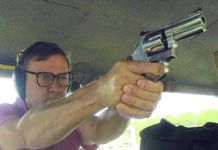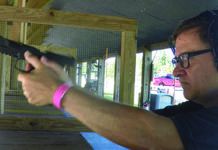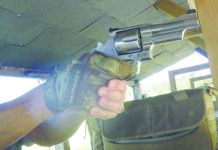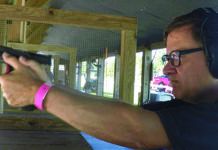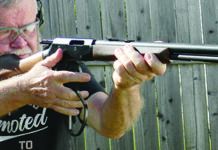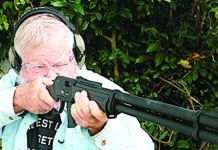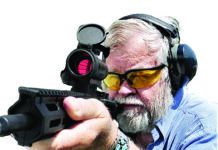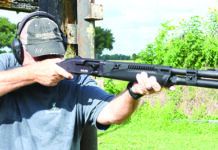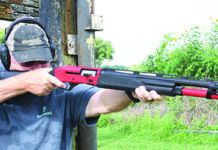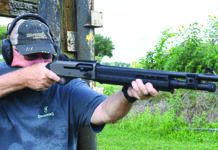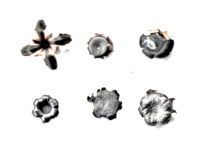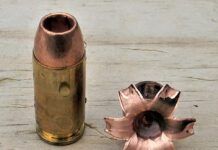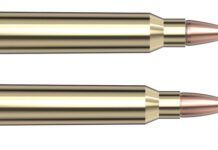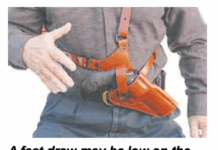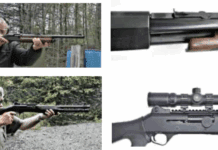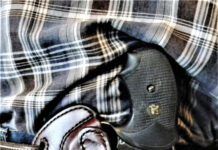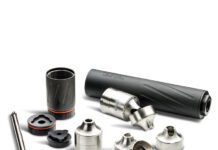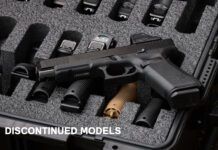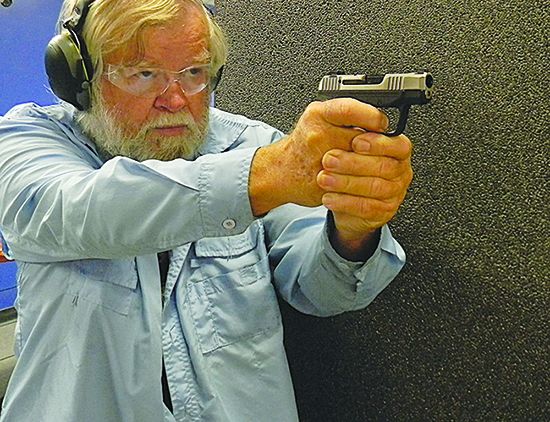Pocket pistols and pocket carry are controversial for some shooters who think smaller handguns just aren’t enough in terms of capacity and presentation. One of our raters is trained in public safety and feels that even well into retirement age, he should carry a handgun capable of taking on personal threats, gangs, and even active shooters with enough rounds of a suitable chambering like 9mm Luger or above. Another rater feels that the pocket 380 Auto is a great carry piece that goes anywhere, anytime without a lot of fuss. He states that situational awareness and avoidance have served him well, and he simply isn’t going to get into a situation that demands a larger gun.
Test guns that fill the bill for the second shooter’s needs are these two 380 Autos:
● Ruger LCP Max 75th Anniversary Stainless 13775, $299, and
● Smith & Wesson’s Bodyguard 2.0 13926, $440.
These micro 380 Auto pistols are great choices for those days when you don’t really want to carry a gun, such as on a Tuesday when you have a backache. Each is far smaller than the double-action-first-shot 380 Auto pistols typified by the Walther PPK or Beretta 84. Yet each features a generous magazine capacity and good reliability. Also, they are much easier to shoot well than the original 380 Auto Ruger LCP or Smith & Wesson Bodyguard.
Certainly, the newer guns address the first rule of personal defense, and that is to have a gun. They also allow the concealed-carry shooter to have a gun with minimal weight penalty, each pistol weighing around 10 ounces unloaded. Here’s what we thought about each one in more detail:
Ruger LCP Max 75th Anniversary Stainless 13775 380 Auto
$299
Gun Tests grade: B+
The Ruger LCP Max is reliable, lightweight, and makes a good pocket gun. It isn’t useful much past 10 yards, in our opinion. Across a bedroom or apartment, it will put all the shots into one hole. It is the archetypal “Get Off Me” gun. It suffered in comparison to the Smith & Wesson in combat accuracy, but not by much. A trained shooter is needed to mark the difference.
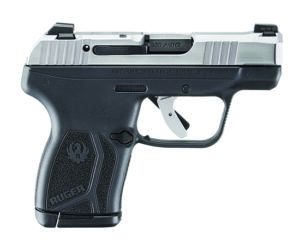
| Action | Semi-automatic, blowback, hammer fired |
|---|---|
| Trigger | Single action |
| Overall Length | 5.2 in. |
| Overall Height | 4.2 in. |
| Maximum Width | 0.81 in. |
| Weight Unloaded | 10.6 oz. |
| Weight Loaded | 11.8 oz. |
| Barrel Length | 2.8 in. |
| Capacity | 10 or 12 rounds |
| Slide | Stainless steel |
| Slide Retraction Effort | 10.5 lbs. |
| Frame | Black glass-filled Nylon |
| Front Strap Height | 1.6 in. |
| Rear Strap Height | 2.5 in. |
| Grip | Black rough texture |
| Grip Thickness Maximum | 1.0 in. |
| Grip Circumference Maximum | 4.9 in. |
| Front Sight | Tritium white dot |
| Rear Sight | Fixed U notch |
| Trigger Pull Weight | 4.15 lbs. |
| Trigger Span | 2.5 in. |
| Magazines | (1) 10 |
| Magazine Cost | $28, 12 round |
| Warranty | None Stated |
| Telephone | (336) 949-5200 |
| Website | Ruger.com |
| Made In | U.S. |
We cannot recall such a wide price spread between handguns as on this stainless-steel-slide pistol. A statewide store in South Carolina with several branches had the Ruger LCP Max Anniversary Edition on sale for $269, while one online shop was asking $367. We actually paid $299 plus tax in a local shop. The pistol was supplied with a 10-round magazine. We purchased a 12-round magazine in the shop for $32; online, the 12-round magazines were $52.55 for a two pack, not a bad price for a modern dual-column magazine. The total price with the second magazine was then $331 plus tax, versus $440 plus tax for the Bodyguard 2.0, which was supplied with a spare magazine. The Ruger was delivered in a cardboard box, same as the S&W, and supplied with a zipper bag and a thin but usable pocket holster.
The LCP Max is a single-action hammer-fired pistol, although it looks like it would be striker fired. The LCP Max 380 Auto pistol is a development of the original LCP and LCP II. Reliability has been steady with this pistol line. Getting a grip and firing position with the original LCP was difficult. The LCP II was much improved, with a superior trigger and sights, and the LCP Max is a high-capacity variant of the II. The Max pistol is well designed, without sharp edges or obvious defects. While one rater feels that firing any 380 Auto pistol past a few yards is something of a stunt, the LCP Max is a decent shooter. The addition of a longer Max magazine causes a half-inch more of height, something we can live with. Another rater feels that the extra length of the Ruger, with its extended magazine, and the S&W 2.0 as well, makes for just enough greater height and width over smaller pistols that an average shooter will be more comfortable firing the larger Max and 2.0 pistols.
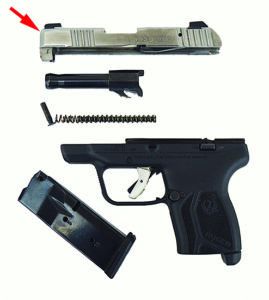
relatively snag free where it counts along the muzzle.
The Max frame is glass-filled nylon with a different grip treatment than the Smith & Wesson Bodyguard. The Ruger isn’t roughened in the grip as thoroughly as the Smith & Wesson. The LCP Max doesn’t resemble any larger handgun in the Ruger line, save perhaps the SR9, and that is superficial. The Ruger’s grip angle is not as pleasant as the Bodyguard 2.0. The grip tang isn’t as long as the Smith & Wesson, but the slide doesn’t bite the hand because the Ruger has a kind of rounded hump at the rear of the slide and frame. The result is a pistol that feels slide heavy compared to the Bodyguard 2.0. However, the sights are good and are presented nicely to the eye in the firing grip. The grip, however, feels rounded down, and the stippling, while adequate for a firing grip, isn’t as complete as the Bodyguard 2.0, we believe.
Compared to the original LCP and LCP II, the LCP Max grip is made only a half-inch thicker to accommodate the high-capacity magazine. The 10-round magazine is difficult to load to full capacity, so is the Smith & Wesson, but we managed. We fired the pistols with 9 rounds in the shorter magazines and 11 in the longer magazines for most of the test. We resorted to magazine loaders to confirm advertised capacity and reliability with a full gun load. Both pistols were difficult to load to full capacity with the extended magazine, the Smith & Wesson perhaps a bit easier after all magazines were broken in at the end of the test. The baseplate of the Ruger magazine seemed loose, but the mag never failed to feed.
The pistol’s slide lock isn’t ambidextrous, favoring the right-handed shooter. The magazine catch may be reversed for left-hand use, useful for southpaw shooters.
In this 75th Anniversary Edition pistol, the slide is polished stainless steel. A laser-etched logo is burned into the top of the slide in front of the rear sight. Slide serrations both front and rear work well. They are longer and higher than the Bodyguard 2.0’s.
We spent a lot of time discussing sights. The deep U-notch of the Ruger gets high marks, and the raters felt it was the better set up. Combined with a high-visibility front sight, the Ruger LCP Max would deliver rapid target acquisition. We would note that either rear sight, S&W or Ruger, may be loosened and drifted for windage adjustment. The front sights are dovetailed in, and moving them would be a serious chore and would require a sight pusher. Any adjustment could easily be done with the rear sight; simply loosen the screw and bump the sight with a brass mallet. Takedown is simple enough. Using a small screwdriver, force the disassembly screw out, and the slide is easily removed. Pluck out the dual recoil-spring assembly and then the barrel. Reassembly is in reverse. Neither pistol is as easily field-stripped as a full-size handgun, but neither is difficult either.

During the range test firing, we noticed how the Ruger sat lower in the hand, which we liked. During the combat phase of the firing test, we were able to fire with similar accuracy compared to the S&W Bodyguard in some drills, but in speed to a first shot hit and rapid fire, the S&W is noticeably more efficient. Sometimes the combat groups were nearly the same size, but we had the impression the Ruger was slightly slower in perforating the paper. The Ruger is not as steady as the S&W, but it isn’t bad.
Speed loads are acceptable with the Max, but not quite as smooth as the Bodyguard 2.0. In the end, the raters found the Smith & Wesson pistol superior in combat ability, while the Ruger LCP Max is useful, just not as capable as the Smith & Wesson. We rated the Ruger down a half grade on combat ability and another half grade on poor grip treatment compared to the S&W.
Because the Bodyguard had a tie up marring its otherwise good performance, we fired a second box of Black Hills and Honey Badger ammunition through it. There were no more problems. We properly rated the pistol down, but it seems the malfunction was a singular event.
Our Team Said: The handguns performed well in the context of pocket-pistol performance. Each would serve as a pocket pistol or carried in a concealment holster. One rater summed it up by saying, “If carrying a 380 Auto as a backup or just-in-case gun, the Ruger is fine; save the money if you are not going to practice hard. If pocket carry is your mantra and you wish your pocket gun to be all it can be, then the Smith & Wesson offers better performance.” The Smith may cost more, but it is worth the extra price for enhanced performance. We especially like the manual safety, which the Ruger lacked.
| 380 AUTO RANGE DATA | ||
|---|---|---|
| Hornady American Gunner 90-grain XTP 90104 | Ruger LCP Max 75th Anniversary | Smith & Wesson Bodyguard 2.0 |
| Average Velocity | 888 fps | 894 fps |
| Muzzle Energy | 158 ft.-lbs. | 160 ft.-lbs. |
| Small Group | 2.8 in. | 2.6 in. |
| Average Group | 3.7 in. | 3.4 in. |
| Speer Lawman 95-grain FMJ 53608 | Ruger LCP Max 75th Anniversary | Smith & Wesson Bodyguard 2.0 |
| Average Velocity | 901 fps | 876 fps |
| Muzzle Energy | 171 ft.-lbs. | 162 ft.-lbs. |
| Small Group | 3.2 in. | 2.2 in. |
| Average Group | 3.7 in. | 3.2 in. |
| SIG 365 V-Crown 90-grain JHP E380A1-365 | Ruger LCP Max 75th Anniversary | Smith & Wesson Bodyguard 2.0 |
| Average Velocity | 867 fps | 881 fps |
| Muzzle Energy | 150 ft.-lbs. | 155 ft.-lbs. |
| Small Group | 3.6 in. | 3.3 in. |
| Average Group | 4.3 in. | 3.8 in. |
We fired groups at 15 yards from a bench using an MTM Case-Gard K-Zone Pistol Rest. We measured velocities with a Competition Electronics Pro Chrony. The first screen of the chronograph was 10 feet from the muzzles. JHP = jacketed hollow point. FMJ = full metal jacket. XTP = eXtreme Terminal Performance jacketed hollow point.
Written and photographed by Bob Campbell, using evaluations from Gun Tests Team members. GT



